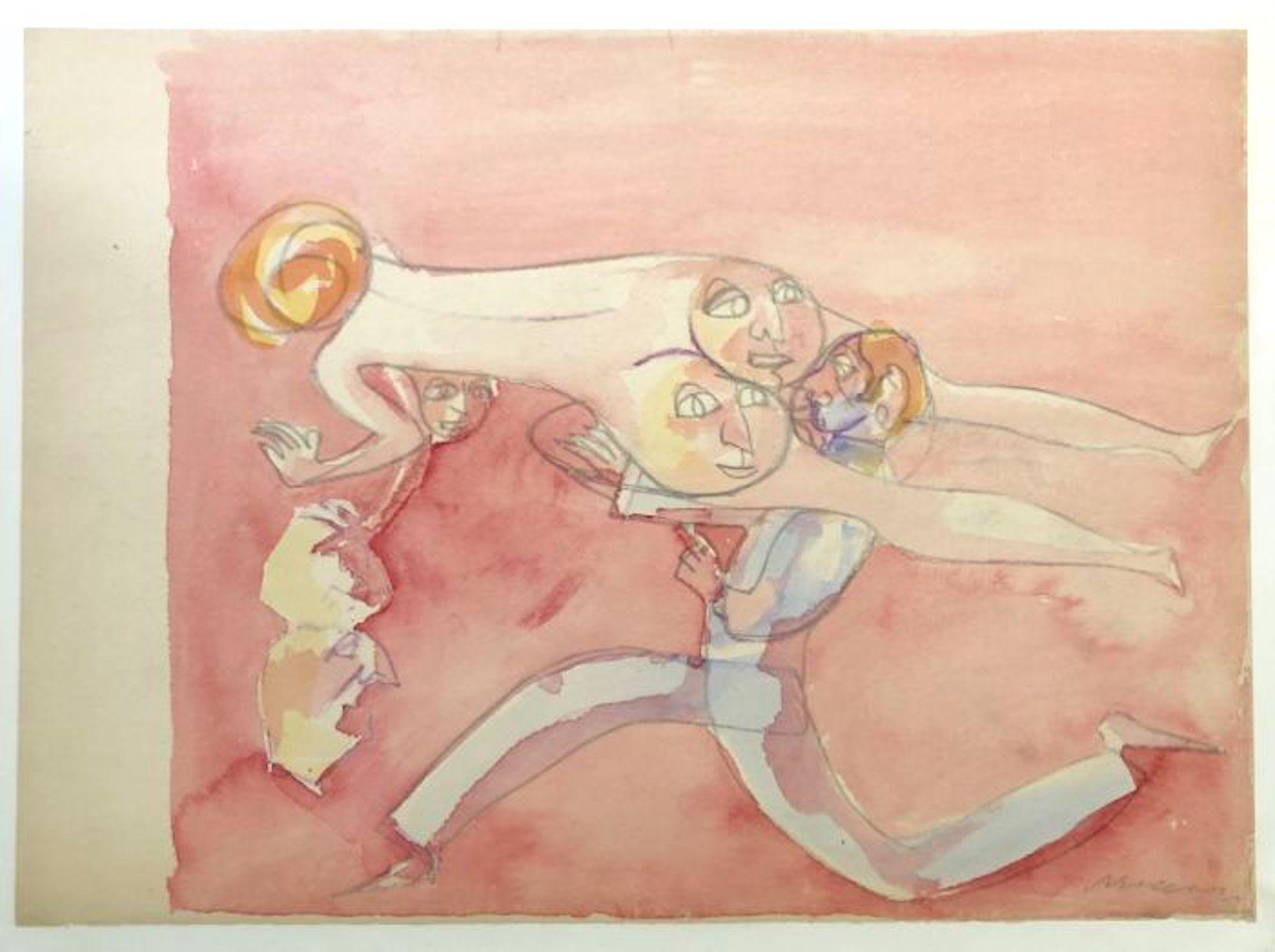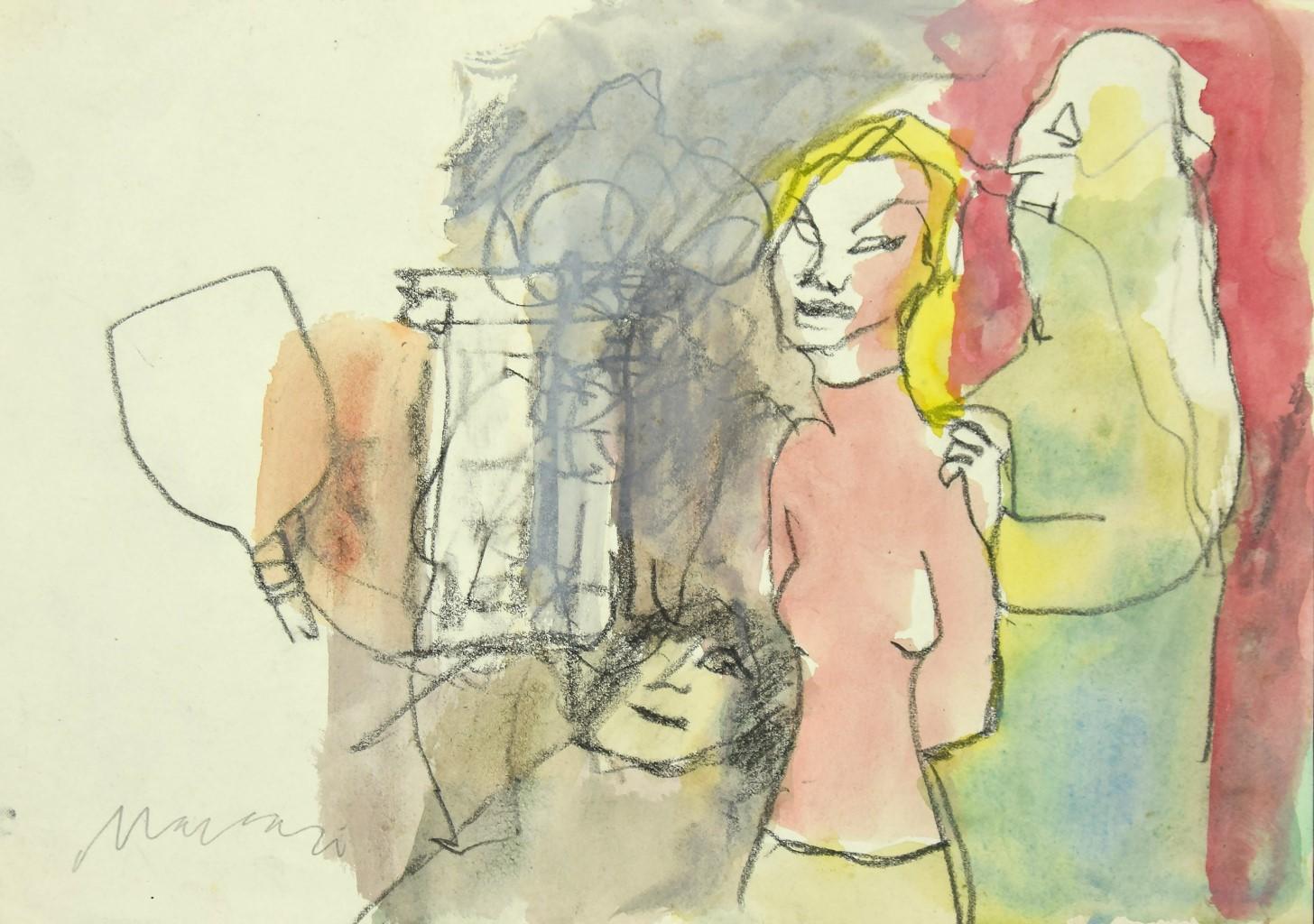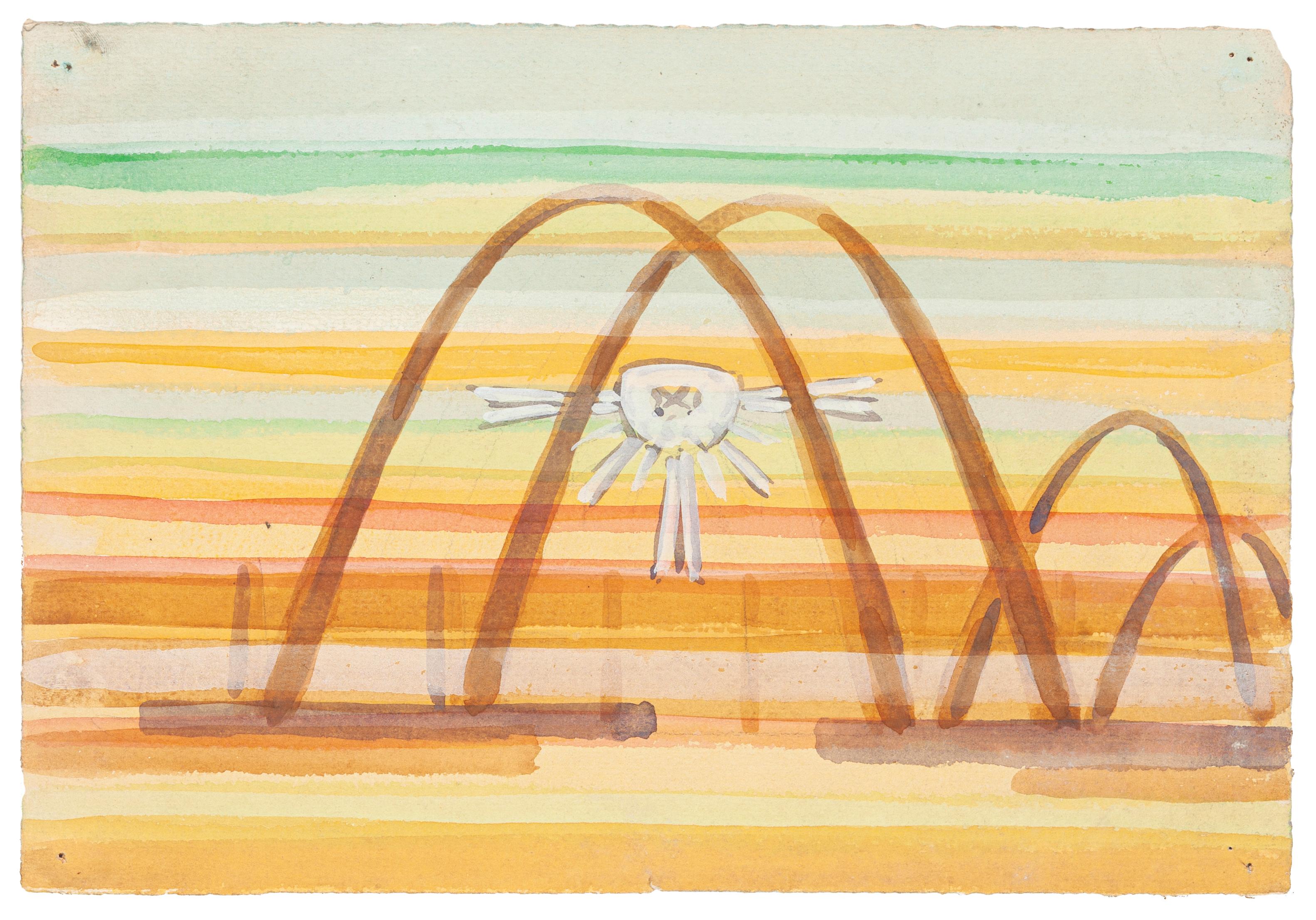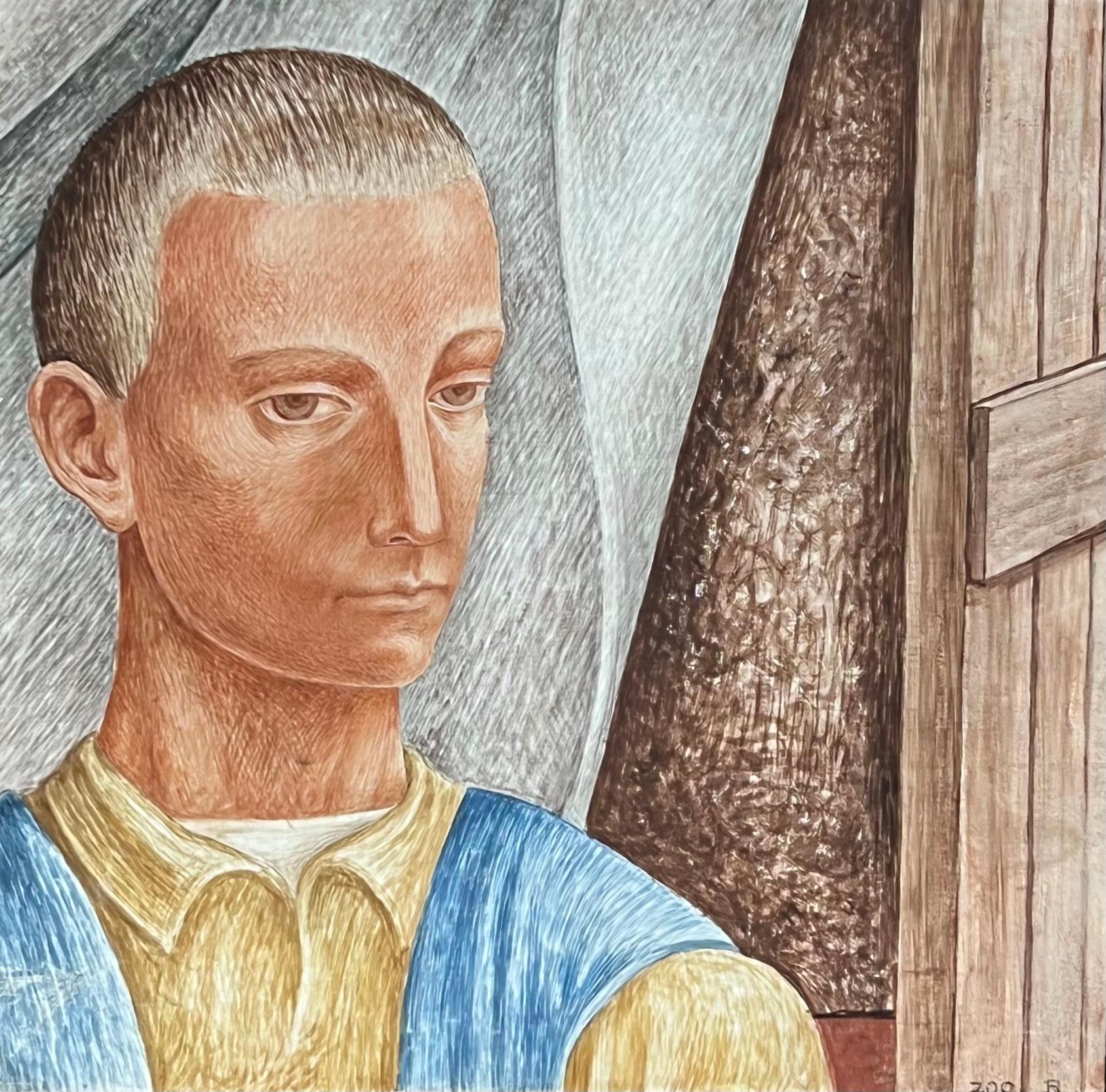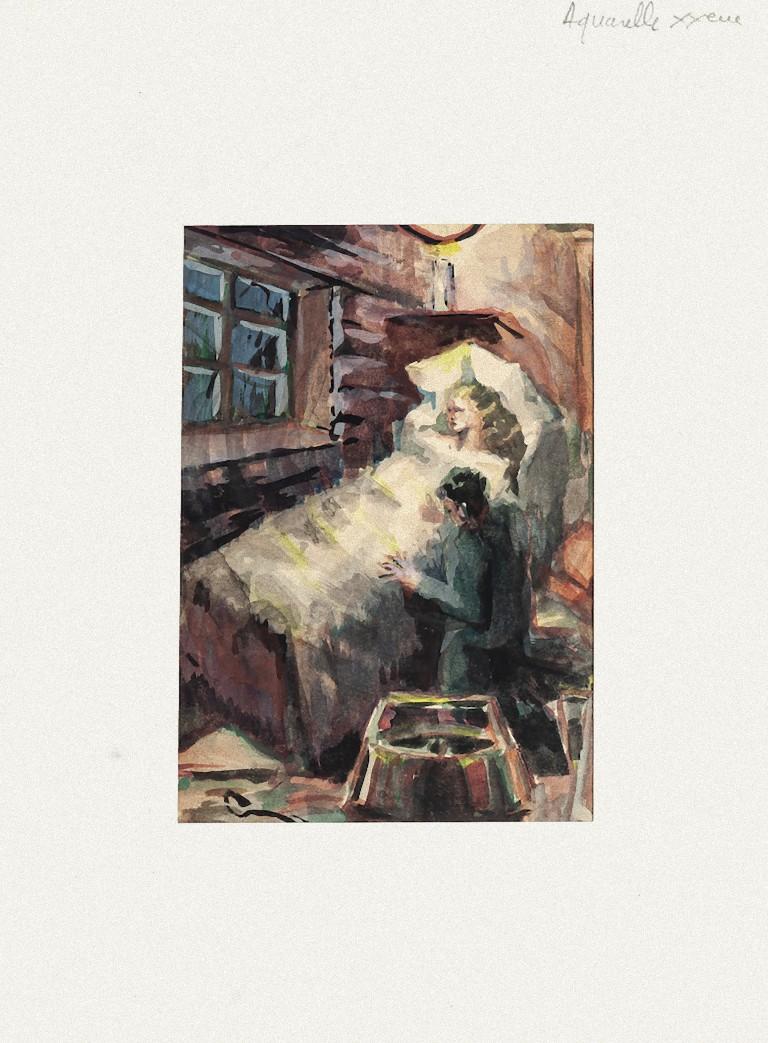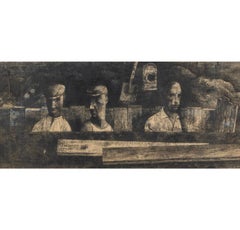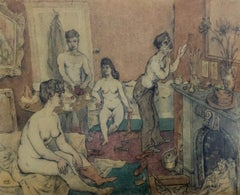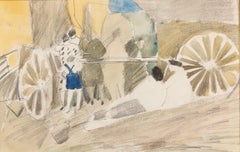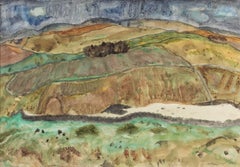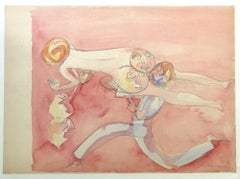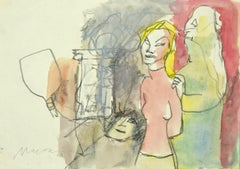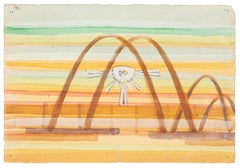Items Similar to The Tramp, Watercolour and Pencil Painting by William Roberts, 1945 circa
Want more images or videos?
Request additional images or videos from the seller
1 of 6
William RobertsThe Tramp, Watercolour and Pencil Painting by William Roberts, 1945 circa1945 circa
1945 circa
Price Upon Request
Price Upon Request
Price Upon Request
Price Upon Request
Price Upon Request
Price Upon Request
Price Upon Request
Price Upon Request
Price Upon Request
Price Upon Request
About the Item
The Tramp, Watercolour and Pencil Painting by William Roberts, 1945 circa
Additional information:
Medium: Watercolour and pencil
35 x 53 cm
13 3/4 x 20 7/8 in
William Roberts was a British artist, sometimes known as the 'English Cubist'.
Born in London Fields, Hackney in 1895, Roberts's artistic ability was evident from an early age, the teachers at his primary school allowed him to devote class time to drawing and eventually his art mistress suggested he be transferred to a school with greater art resources. Upon leaving school Roberts was apprenticed to a commercial art firm and he attended evening classes run by William P. Robins at St Martins School of Art. At fifteen years old, Roberts won a London County Council Scholarship to study at the Slade School of Art where his fellow students included Dora Carrington, Paul Nash and Stanley Spencer, among many other notable artists.
He won the Melville Nettleship Prize for figure painting composition as well as a further prize for drawing in 1913, the same year he left the Slade. He then spent some time travelling France and Italy, likely further igniting a love for Cubism and Post-Impressionism that had been growing during his time at the Slade fuelled by his friendship with David Bomberg. In these years prior to the outbreak of the First World War, Roberts was seen as a pioneer, among English artists due to the way he used abstract images, later describing himself as an English Cubist. He joined Roger Fry's Omega Workshops, exhibiting with Fry's Grafton Group in 1914. Tensions in the group drew him to Percy Wyndham Lewis instead, who was developing a style of geometric abstraction which was intended to be a British take on Futurism, named 'Vorticism' by Ezra Pound. Roberts' work featured in both editions of the Vorticist magazine BLAST.
By 1916, Roberts had enlisted in the Royal Field Artillery and two years later, while his Brigade was retreating from The Somme, he received a summons from the Canadian War Records Office to return to England to begin work as an official war artist. Following the war, the artist began to exhibit widely, with his first solo exhibition in 1923 and several of his paintings produced in this decade purchased by the Contemporary Art Society for provincial art galleries in the UK. He also became a visiting teacher at the Central School of Art where he continued to teach until 1960, and in 1928 showed at the Venice Biennale for the first time.
Throughout the 1930s, the angular style of Roberts' earlier work was replaced with a more rotund use of line, giving the work a sculptural quality. During the inter-war years, the artist and his wife temporarily relocated to Oxford, where he undertook a few assignments for the War Artists' Advisory Committee. Following their return to London, Roberts expanded the scale and colour of his painting and increased the dramaticism of the subject matter to fit his growing enthusiasm for exhibiting with the Royal Academy, and it is these paintings he is probably best remembered for.
A retrospective of the artist's work was held at the Tate in 1966 and he was elected Royal Academician, he also declined the offer of an OBE the same year. Having lived and worked at 14 St Mark's Crescent, Primrose Hill since 1946, he died there in January 1980.
- Creator:William Roberts (1788 - 1867, British)
- Creation Year:1945 circa
- Dimensions:Height: 13.75 in (34.93 cm)Width: 20.88 in (53.04 cm)
- Medium:
- Period:
- Condition:
- Gallery Location:Kingsclere, GB
- Reference Number:1stDibs: LU2718214575982
About the Seller
No Reviews Yet
Vetted Professional Seller
Every seller passes strict standards for authenticity and reliability
Established in 2010
1stDibs seller since 2024
41 sales on 1stDibs
Typical response time: 7 hours
- ShippingRetrieving quote...Shipping from: Kingsclere, United Kingdom
- Return Policy
Authenticity Guarantee
In the unlikely event there’s an issue with an item’s authenticity, contact us within 1 year for a full refund. DetailsMoney-Back Guarantee
If your item is not as described, is damaged in transit, or does not arrive, contact us within 7 days for a full refund. Details24-Hour Cancellation
You have a 24-hour grace period in which to reconsider your purchase, with no questions asked.Vetted Professional Sellers
Our world-class sellers must adhere to strict standards for service and quality, maintaining the integrity of our listings.Price-Match Guarantee
If you find that a seller listed the same item for a lower price elsewhere, we’ll match it.Trusted Global Delivery
Our best-in-class carrier network provides specialized shipping options worldwide, including custom delivery.More From This Seller
View AllStudy for Men in the Trench, Pen, Ink & Watercolour on Paper Painting 1950 circa
By Reginald Brill
Located in Kingsclere, GB
Study for Men in the Trench, Pen, Ink & Watercolour on Paper Painting 1950 circa
Additional information:
Medium: Pen, ink and watercolour on paper
11 3/4 x 26 in
29.8 x 68.5 cm
Reginald " Reggie" Brill was a versastile 20th century artist and teacher.
Brill was born in London in 1902 and spent his early childhood there and in Yorkshire. By the time of the First World War, at the age of 13, he was living in lodgings in London, working in a City office and attending St Martins School of Art in the evenings. Considering his lack of education, winning a scholarship to The Slade (now part of University College London) in 1921 where he studied under Henry Tonks for three years, was a huge achievement.
On leaving The Slade he found patronage in Lincolnshire, but by the time of the General Strike (1926) he had returned to London and was working on Lansbury's Labour Weekly. He married Rosalie, also an artist, and in 1927 won the Prix de Rome in Decorative Painting. Following two years at The British School in Rome, Brill went to teach at Blackheath School of Art. During 1930 he spent three months painting in Egypt and it was there that he met Col. T G Gayer-Anderson, one of the twin brothers who were to bequeath The Little Hall in Lavenham as a hostel for art students. It was there that Brill retired to act as warden, thus continuing his nurturing of art students until his death in 1972.
Brill took up his appointment at The School of Art, Kingston upon Thames in January 1934. It was situated in the Technical Institute (Kingston Hall Road) and Brill found it bohemian and disorganised. He proceeded to inject enthusiasm, order and discipline. Within 5 years of his appointment a purpose-built School of Art was opened in Knights Park. It remained open throughout the war and by 1945 there was a waiting list for places. Under the skilled and totally dedicated direction of Brill, Kingston School of Art became established with national reputation for excellence. In 1961 Sir Charles Wheeler opened the new building at Knights Park. Costing £100,000, this more than doubled the size of the Art School.
Brill, was a well-known figure in Kingston. His eloquence made him popular as a guest speaker and his promotion of Art and Design stretched well beyond the doors of Knights Park. Apart from establishing two of the main buildings which makeup what is now known as the Faculty of Design, one of the most visible local contributions he made was the setting up of a topographical collection of paintings depicting Kingston, which has since become known as The Brill Collection at Kingston Museum. Brill gained huge respect and admiration from the hundreds of pupils who studied at Kingston during his 30-year leadership.
He published two books, Modern Painting 1946 and Art as a Career 1962, both bearing a strong educational angle. He regularly exhibited along with leading artists of his era at The Royal Academy, both his paintings and his acutely observed drawings. All the while he was a prolific artist, although reading his diaries, intensely self-critical. His perfectionism, acute powers of observation and relentless research can be seen in his drawings, which via the media and methods he explored throughout his life reflect mid 20th century British Art at its most typical. His major series of work, known as 'The Martyrdom of Man', was carried on in parallel to his career as a teacher. These paintings reflect his care for fellow man and depict people at work, e.g., The Operation, The Jury, Linemen, Waiting Room and Rest, which recently sold at Sotheby’s and was specially restored for The Brill Retrospective. His smaller works also play with the theme of everyday events and communication amongst people, such as The Bull Ring and Market Place paintings.
Brill's name is associated particularly with human figure compositions, but he also worked on landscapes, portraits and details of plants, animals, interiors etc. As one would expect he moved from one media to another, and his unusual hand painted and cut paper mosaics...
Category
20th Century Figurative Drawings and Watercolors
Materials
Pen
Student Life, Morning (Gunter Grove, Chelsea), Watercolour Painting, 1941
Located in Kingsclere, GB
Student Life, Morning (Gunter Grove, Chelsea), Watercolour Painting, 1941
Additional information:
Medium: Watercolour over pen and ink
12 x 15 in
30.5 x 38.1 cm
Signed and dated; si...
Category
20th Century Figurative Drawings and Watercolors
Materials
Watercolor
Wagons in the Field, Poland, Watercolour and Charcoal Painting, 1958
Located in Kingsclere, GB
Wagons in the Field, Poland, Watercolour and Charcoal Painting, 1958
Additional information:
Medium: Watercolour and charcoal
20.6 x 32.3 cm
8 1/8 x 12 3/4 in
Tadeusz Piotr (Peter)...
Category
20th Century Abstract Paintings
Materials
Watercolor
On the Meldons Road, Watercolour Painting by William George Gillies, circa 1940s
Located in Kingsclere, GB
On the Meldons Road, Watercolour Painting by William George Gillies, circa 1940s
Additional information:
Medium: Watercolour
41.5 x 59 cm
16 3/8 x 23 1/4 in
Signed
William George G...
Category
20th Century Landscape Drawings and Watercolors
Materials
Watercolor
Street Scene, Pencil Drawing by Edward Burra, 1930s circa
By Edward Burra
Located in Kingsclere, GB
Street Scene, Pencil Drawing by Edward Burra, 1930s circa
Additional information:
Medium: Pencil drawing
49.5 x 61 cm
19 1/2 x 24 1/8 in
With Estate stamp
Painter in watercolour (f...
Category
20th Century Figurative Drawings and Watercolors
Materials
Pencil
Wagons in the Field, Poland by Peter Potworowski, Watercolour Landscape, 1958
By Peter Potworowski
Located in Kingsclere, GB
Wagons in the Field, Poland
Category
20th Century Landscape Drawings and Watercolors
Materials
Charcoal, Watercolor
You May Also Like
Helen Steinthal (1911-1991) - 20th Century Watercolour, The Warning
Located in Corsham, GB
A striking scene depicting a boy on horseback alerting a group of people on the beach pointing into the distance as the concerned people gather. The scene shows classical inspiration...
Category
20th Century Figurative Drawings and Watercolors
Materials
Watercolor
$291 Sale Price
20% Off
Sessual - Charcoal and Watercolor by M. Maccari - 1950s
By Mino Maccari
Located in Roma, IT
Sessual is a beautiful original charcoal and watercolor on paper realized by Mino Maccari. Hand signed on pencil on lower right margin. The paper sheet is stuck on another sheet. Ver...
Category
1950s Contemporary Figurative Drawings and Watercolors
Materials
Charcoal, Watercolor
Figure - Original Pencil and Watercolor on Paper by Mino Maccari - 1980s
By Mino Maccari
Located in Roma, IT
Figure is an original modern artwork realized the 1980s by the Italian artist Mino Maccari (Siena, 1898 - Rome, 1989).
Original pencil and watercolor drawing on Ivory paper.
Hand-...
Category
1980s Modern Figurative Drawings and Watercolors
Materials
Pencil, Watercolor
Composition - Watercolor on Paper by J.-R. Delpech - Mid 20th Century
By Jean Delpech
Located in Roma, IT
"Composition" is an original drawing in watercolor on paper, realized by Jean Delpech (1988-1916).
The state of preservation of the artwork is very good.
Sheet dimension: 18.5x27 ...
Category
Mid-20th Century Contemporary Figurative Drawings and Watercolors
Materials
Watercolor
WPA Mural Study 1940 American Scene Modern Social Realism Figurative Mid Century
By Michael Loew
Located in New York, NY
WPA Mural Study 1940 American Scene Modern Social Realism Figurative Mid Century
Michael Loew (1907-1985)
Detail for Mural (Social Security Building Washington D.C.)
24 x 24 inches ...
Category
1940s American Realist Figurative Paintings
Materials
Canvas, Oil
Sympathy - Watercolor on Paper by Pierre Laurent Brenot - Mid-20th Century
By Pierre Laurent Brenot
Located in Roma, IT
Sympathy is a watercolor on paper realized by Pierre Laurent Brenot (1913-1998)
Good conditions, aged.
included the Passepartout: 32 x 24.
Here the artwork represents a man on h...
Category
Mid-20th Century Figurative Drawings and Watercolors
Materials
Watercolor

